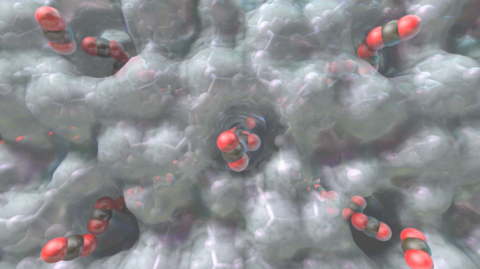Effect of Partial Charge Calculation Method on Adsorption Thermodynamics in Metal-organic Frameworks
Summary
In classical molecular simulations, electrostatic contributions to the potential energy are typically accounted for by assigning partial charges to some or all atoms in the system. Partial charges are not real observable quantities and, as such, depend on the method chosen to either heuristically assign those charges or compute them using ab initio methods. The thermodynamic properties computed via a subsequent molecular simulation utilizing the computed charges are thusly dependent on the charge calculation scheme. In this work, we compute partial charges for crystalline metal-organic framework materials using various methods and then use those charges to simulate light gas adsorption in the framework. The adsorption properties obtained by simulation then serve as a qualitative measure of the variability that may follow from the choice of partial charge calculation method.
Description

Depiction of interactions of carbon dioxide with a porous adsorbent.
Electrostatic interactions are an important contribution to the interatomic or intermolecular potential energy in any system, whether homogeneous (bulk phase) or heterogeneous (fluid and confining material or multiple fluid phases). This is particularly true for heterogeneous systems in which the guest molecules have polar moments such as a dipole moment (e.g., water), a quadrupole moment (e.g., Carbon Dioxide or diatomic Nitrogen), or an octupole moment (e.g., Methane). Proper, but computationally expensive, calculation of the electrostatic potential energy requires quantum-mechanical calculations. Such ab initio methods may be incorporated into molecular simulations to model complex systems, e.g., the Car-Parrinello Molecular Dynamics method, though at high computational cost. For reasons of efficiency, classical molecular simulations often account for electrostatic interactions by assigning partial charges to each constituent atom in the fluid and, if applicable, other materials in the system. The electrostatic contribution to the potential energy is, then, just the Coulomb energy of each charge pair. These partial charges are, of course, artifacts that are not actually observable in real system. Calculation and subsequent assignment of partial charges to atoms is dependent on the calculation method chosen; many methods have been introduced. For crystalline materials, such as metal-organic frameworks (MOF), partial charges are often computed from ab initio calculations of some prescribed method. Even for a particular MOF, there is often great variation between the charges computed by two methods. This affects the computed potential energy of the simulated system, which determines the state probabilities. Ultimately, the equilibrium thermodynamic properties of a fluid-MOF system depend on the partial charge calculation scheme.
In this project, we use a few partial charge calculation schemes to compute thermodynamic properties via Monte Carlo molecular simulations to provide some qualitative evaluation of the affect of the charge scheme on those properties. The systems chosen for this evaluation are guest-host systems containing Carbon Dioxide adsorbate in a crystalline adsorbent MOF. Due to the great variability in MOF size, shape, adsorbent strength, etc., the adsorption properties of MOFs have been extensively studied via molecular simulations in which partial charges are assigned to the framework atoms. Consequently, it is expected that the metrics of adsorption, including the adsorption isotherm and isosteric enthalpy of adsorption, will depend on the chosen partial charge scheme.
Major Accomplishments
Thus far, we have computed partial charges for a variety of popular MOFs, including ZIF-8 and some from the IRMOF family, using density functional theory and several partial charge methods. These partial charges have been used with available force fields for the dispersion interactions to simulation light gas adsorption in these MOFS. The systems studied are listed below.
Benchmark Partial Charge Calculations and Simulation of CO2 Adsorption by:
Notes:
This site provides electronic structure and thermophysical properties data computed using quantum mechanical and molecular simulation techniques and compiled by NIST under the Standards Reference Data Program.
The National Institute of Standards and Technology (NIST) uses its best efforts to deliver a high quality database of quantum mechanical and molecular simulation data and to verify that the data contained therein have been selected on the basis of sound scientific judgment. However, NIST makes no warranties to that effect, and NIST shall not be liable for any damage that may result from errors or omissions in the Database.
Certain prepackaged simulation programs may be identified in this database. This identification does not imply recommendation or endorsement by NIST, nor does it imply that it is the best available for the purposes described.

